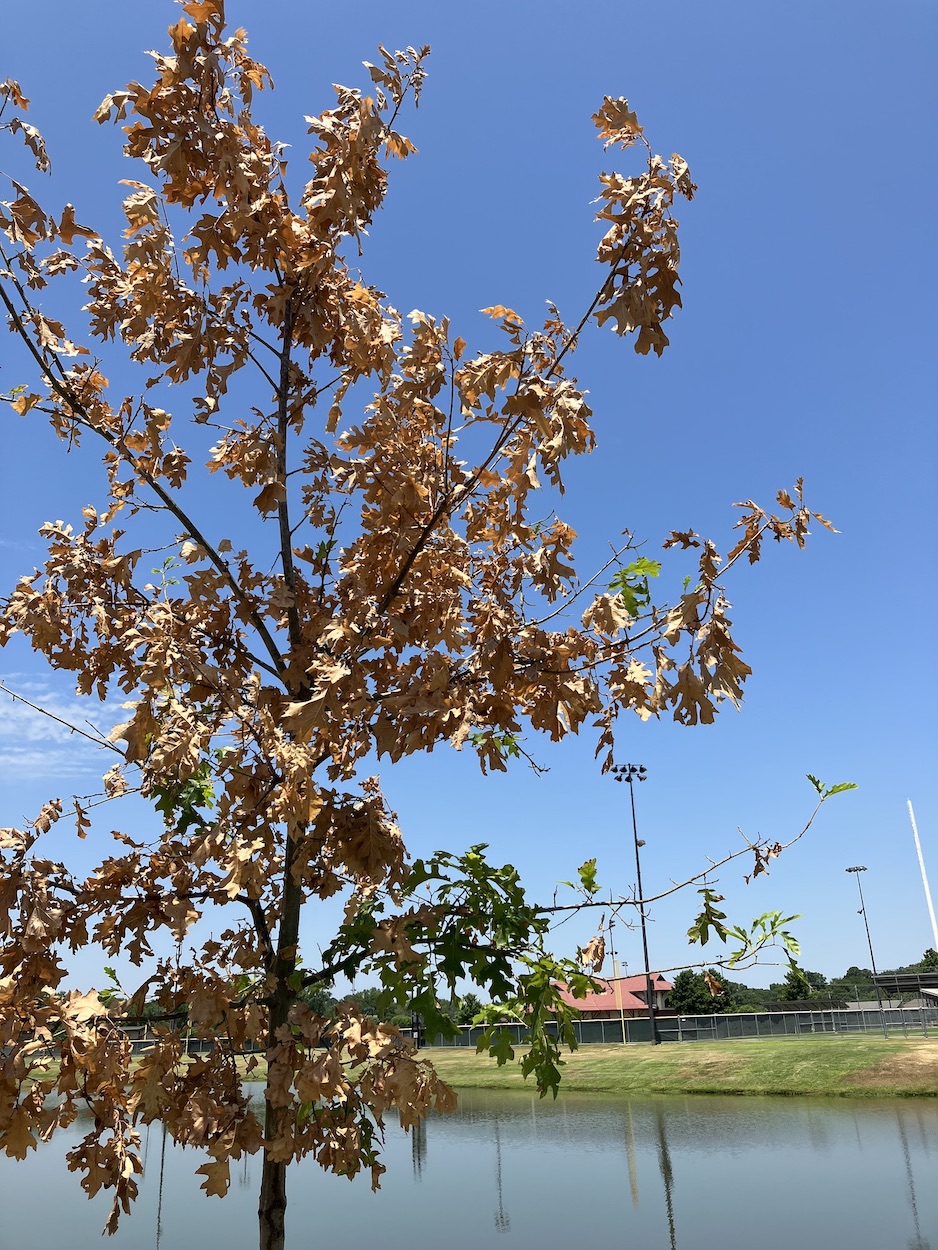July 22, 2022
As drought lingers, trees require smarter approaches for watering
By Tracy Courage
U of A System Division of Agriculture
Fast Facts
- Young trees more susceptible to drought
- Signs of distress: wilting, losing leaves, leaf discoloration
- Watering, mulching can help trees in distress
(665 words)
Related photos: https://flic.kr/s/aHBqjzZ1Bd
LITTLE ROCK — With Arkansas’ prolonged drought taking a toll on trees across the state, now is the time for homeowners to lend some extra attention to their trees that may be in distress.

“People have been calling about their trees losing leaves or starting to get their fall colors way too early, or the bark cracking,” said Krista Quinn, a certified arborist and an agricultural agent with the Cooperative Extension Service’s Faulkner County office, part of the University of Arkansas System Division of Agriculture. “These are all signs of drought distress.”
The prolonged lack of rain and high temperatures across Arkansas has depleted moisture from soil in many areas.
“The two best things we can do to minimize drought damage to trees is to water them and lightly mulch them,” Quinn said. “Watering and mulching trees now may not be enough to get them to produce new leaves or start growing again this season, but it can minimize damage and make them better able to withstand other environmental and pest pressures during the coming year.”
Older trees require hundreds of gallons of water over a week, but their root systems can tap into deeper water sources that younger trees cannot access. Younger trees, especially those in harsh urban conditions, need extra care.
“Turf grasses can usually recover,” Quinn said. “They will go dormant and turn brown. Some trees will also go dormant as a strategy for dealing with drought, so just because it’s defoliating doesn’t mean it’s dying, but it is stressed.”
Homeowners may face time or financial constraints when it comes to caring for their landscaping. Some municipalities may also request that homeowners reduce water use for irrigation like sprinklers and landscape watering to maintain the community water supply.
“For anyone who is trying to maintain their landscape through drought and heat and feel like they have to make decisions — I honestly think trees are the priority,” Quinn said. “They’re expensive to plant, and large trees are irreplaceable. The hot temperatures make us appreciate the shade from a tree even more.”
Tree Watering Tips
- Water under the entire tree canopy and not just at the trunk.
- For newly planted trees, water the area just outside the root zone to encourage roots to grow out away from the trunk into the native soil.
- Irrigate infrequently, but deeply. Watering once a week is usually sufficient as long as the top 4 to 6 inches of soil is wetted. Dig a small hole after watering to make sure the water has percolated through the soil.
- Watering trees in clay soils, compacted soils, or on slopes can be difficult since the water often starts to runoff before the top 4 to 6 inches of soil is wetted. Use a soaker or drip irrigation system to apply a low volume of water over a longer amount of time. Another option is to cycle the water flow on and off every 20 to 30 minutes. Water for 20 minutes, then let the water soak into the slope for 20 minutes, then water again for 20 minutes until the needed amount of water has soaked into the soil.
- Water in the evening or early morning to minimize evaporation.
- Use sprinklers, soaker hoses, watering bags, and buckets to water trees.
- Newly planted trees have a better chance of surviving if they are watered during dry spells for the first two years after planting.
Tree Mulching Tips
- Apply a 2- to 4-inch-deep layer of mulch over tree roots.
- Keep mulch material away from the tree trunk. The goal is to keep the tree roots moist and the trunk dry.
- Mulch as much of the area under the tree as possible, preferably to the outermost edge of the tree's canopy.
- Many different organic products can be used as mulch. Bark, shredded wood, grass clippings, straw, pine needles, and dried leaves are all good options.
- Mulch does not need to be reapplied every year.
- Having a mulch layer more than about 4 inches deep can harm trees.
To learn about extension programs in Arkansas, contact your local Cooperative Extension Service agent or visit www.uaex.uada.edu. Follow us on Twitter and Instagram at @AR_Extension. To learn more about Division of Agriculture research, visit the Arkansas Agricultural Experiment Station website: https://aaes.uada.edu/. Follow on Twitter at @ArkAgResearch. To learn more about the Division of Agriculture, visit https://uada.edu/. Follow us on Twitter at @AgInArk.
About the Division of Agriculture
The University of Arkansas System Division of Agriculture’s mission is to strengthen agriculture, communities, and families by connecting trusted research to the adoption of best practices. Through the Agricultural Experiment Station and the Cooperative Extension Service, the Division of Agriculture conducts research and extension work within the nation’s historic land grant education system.
The Division of Agriculture is one of 20 entities within the University of Arkansas System. It has offices in all 75 counties in Arkansas and faculty on five system campuses.
Pursuant to 7 CFR § 15.3, the University of Arkansas System Division of Agriculture offers all its Extension and Research programs and services (including employment) without regard to race, color, sex, national origin, religion, age, disability, marital or veteran status, genetic information, sexual preference, pregnancy or any other legally protected status, and is an equal opportunity institution.
# # #
Media Contact:
Tracy Courage
Director of Communications-Extension
U of A System Division of Agriculture
501-658-2044